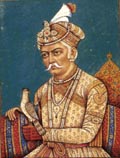



















| | 
Early History
Although coins were
already widely used in India and other native states there were no coins
circulated in Tibet. During the early monarchy, most purchases in Tibet were
made by means of barter. Barley of grain and wool was always a popular currency
item. Also shells, presumably cowrie shells, were used for trade, valued by
number and not by weight. Only in and near the urban communities, mostly
grow up around the great monasteries, was any need for a monetary system for
exchange purposes. The barter system probably continued unchanged until the 13
Th century, when contact between Tibet and China increased during the Yan
Dynasty.
During this period, the Mongols did
sent large donations of silver ingots, bullets or sycees to the Tibetan
monasteries for religious purpose. Because silver was not mined in Tibet this
was probably the first time silver reached Tibet in large quantity. The above
mentioned ingots and sycees were too large in weight and currency for everyday
use and although small change could obtained by cutting them, they were mainly
used for large scale transactions and as a store of wealth.

Akbar
In the 16 Th
century Akbar conquered Northern India. His empire became prosperous and rich in
silver thanks to the Portuguese who brought large quantities of silver from the
newly discovered mines in Mexico to India in trade for spices. Akbar used this
silver to trade with his neighbour countries, including Tibet. In contrast to
the Chinese currency systems, silver in India traditionally circulated as coins,
with a value guaranteed by the issuing authority.
It did not take
long before some of the more powerful border states realized the advantages of
striking coins of their own. At he end of the 16 Th century states as
Nepal and Cooch Behar set op their own mints. Cooch Behar, in particular, struck
large numbers of fine silver coins in the late 16 Th century.
 
Rupee of Cooch Behar
Nara Narayan 1555-1567 (MN 2442)
Cooch Behar seemed
to have been the main beneficiary of trans Himalayan trade at that time. By
striking coins of their own, Cooch Behar and others were able to ensure that
traders could not take the silver (coins) back to India without loss, since the
local coins were not accepted at value in the Moghul territories. In
Tibet, however, where there was no indigenous conage, all silver coins, whether
Moghul, Nepalese or from Cooch behar, were valued on an equal basis. The Tibetan
found the silver coins very convenient as currency and gave all different coins
a standard fixed value, roughly equal to their weight in silver. Because the
content of silver of the coins of Cooch Behar and Nepal are less then the
Indian coins and also the Tibetan fixed
value, it was worthwhile for Cooch behar and the other border states to pay for Tibetan exports with
silver coins, since they were then able to make profit from the degraded silver-alloy of
their coins.
In about 1590, Nepal succeeded in securing the rights for traders and artisans
from Nepal to reside in Lhasa. These traders were able to arrange the direct
bulk trade through Nepal in preference to Cooch Behar which had no local
presence in Lhasa. From then on the power of Cooch Behar waned.
|
 Hans Sanders (NL)
Hans Sanders (NL)